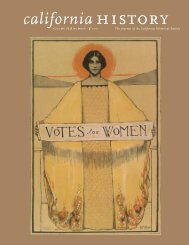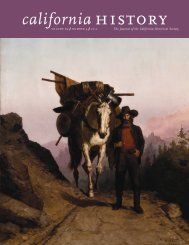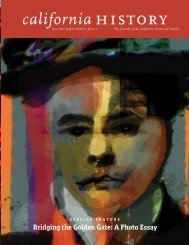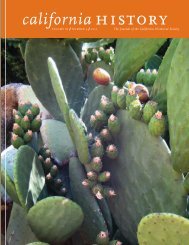Volume 90, Number 1 - California Historical Society
Volume 90, Number 1 - California Historical Society
Volume 90, Number 1 - California Historical Society
You also want an ePaper? Increase the reach of your titles
YUMPU automatically turns print PDFs into web optimized ePapers that Google loves.
The 1920s witnessed the first signs of a reassessment<br />
of the poet’s merit. Despite his wife<br />
and daughter’s best efforts to fan the altar<br />
flame, a University of Illinois professor conducting<br />
research during the summer of 1921 for<br />
a compendium of Joaquin’s poems could find<br />
no copies of any of Miller’s books in a dozen<br />
Bay Area bookshops. This neglect presaged an<br />
opening fusillade on the frontier bard’s reputation.<br />
64 Concurrently, the Hights was falling into<br />
a state of disrepair. A journalist visiting it in 1923<br />
described the Abbey’s broken windows and wideswinging<br />
doors, Margaret Miller’s cottage on the<br />
verge of collapse, the stone monuments vandalized,<br />
great trees felled, and the acacia thickets<br />
“ruthlessly cut away.” 65 Resisting this decline of<br />
home and reputation, one or two of Miller’s bestknown<br />
verses would habitually appear, at least<br />
until the 1950s, in American poetry anthologies.<br />
While a handful of poems lived on, the prolific<br />
writer’s journalism more or less died with him.<br />
Yet Miller, more than one biographer acknowledges,<br />
regarded his prose more highly than his<br />
poetry. Indeed, journalism came easily to him.<br />
In Oregon in the early 1860s, he ran two shortlived<br />
newspapers. Throughout his career, he was<br />
writing constantly about his travels, initially in<br />
personal diaries and, later, on assignment for<br />
newspapers. His outspoken prose—both frank<br />
and moralistic—was spiked with humor and<br />
country argot. With the same brio with which he<br />
confronted swindlers and marauding indigenous<br />
people in the Sierra, he lambasted crooked land<br />
speculators and irresponsible politicians.<br />
One of his early pet complaints was the deplorable<br />
condition of Oakland’s roads. In a characteristically<br />
exaggerated account of a real event,<br />
he described his attempt to give a lecture in the<br />
neighboring settlement of Walnut Creek. Confronting<br />
the men who had invited him to speak<br />
with the lack of passable roads and his inability<br />
to walk due to prior war injuries, Miller was<br />
asked if he could swim: “Yes.” “Then swim to<br />
Contra Costa,” he was advised. “Splendid good<br />
swimming all the way. Take the water at the San<br />
Francisco wharf, swim the bay of San Francisco,<br />
then the San Pablo Bay, then Suisun Bay, then<br />
up the Sacramento river, then up Walnut Creek<br />
to the schoolhouse, where the committee will<br />
be out on the porch with banners and bands to<br />
receive you.” 66<br />
Miller’s blend of candor and the vernacular<br />
enjoyed wide appeal. Besides the New York–based<br />
Independent, two other journals, the Chicago<br />
Times and the San Francisco Call, regularly carried<br />
his byline. With the wide proliferation of<br />
Miller’s poetry and his prose, the hospitality of his<br />
barbecues, and the eccentricity of his ranchero<br />
life and appearance, it is not surprising that the<br />
Hights and its environs became, by the 18<strong>90</strong>s, a<br />
habitation for area artists and a destination for<br />
visiting celebrities and local curiosity seekers.<br />
When Elbert Hubbard and Benjamin Fay Mills<br />
descended from the tram that terminated in the<br />
little settlement of Dimond, the conductor counseled<br />
them, “Take that road and sail on.” “He<br />
smiled,” Hubbard recalled, “in a way that indicated<br />
that he had sprung the allusion before and<br />
was pleased with it.” 67<br />
Phoebe Cutler is an independent scholar. Recipient of<br />
the Heritage/Preservation Award (National Endowment for<br />
the Arts, 2001) and the Rome Prize (American Academy in<br />
Rome, 1988–89), she is the author of The Public Landscape of<br />
the New Deal (Yale University Press, 1986), “Joaquin Miller’s<br />
Trees, Pts. 1 & 2,” Eden: The Journal of the <strong>California</strong> Garden<br />
& Landscape <strong>Society</strong> 13, nos. 2 and 3 (2010), “Sutro Baths:<br />
Caracalla at Lands End,” Eden: The Journal of the <strong>California</strong><br />
Garden & Landscape <strong>Society</strong> 12, no. 1 (2009), and “The Rise<br />
of the American Municipal Rose Garden, 1927–1937,” Studies<br />
in the History of Gardens and Designed Landscapes 25, no. 3<br />
(July–Sept. 2005).<br />
61









